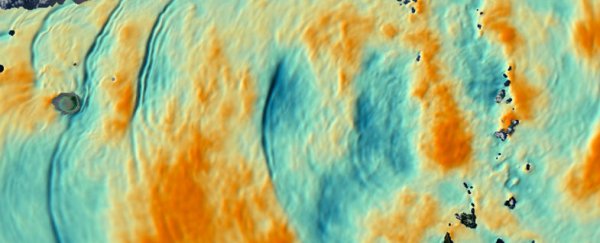The waves most of us are familiar with crash against our shores with hypnotic regularity. They're beautiful and powerful, and yet they pale in comparison to the massive waves we can't see, which are taking shape beneath the ocean's surface.
Now, for the first time, a team of international researchers has used experimental data to simulate the most fearsome of these giant underwater waves - a 500 metre-tall behemoth that forms in the Luzon Strait between the Philippines and China. Using a network of sensors, they've created a detailed picture of how these waves form, grow, travel, and eventually fade away.
"What this report presents is a complete picture, a cradle-to-grave picture of these waves," mechanical engineer and lead author Thomas Peacock, from MIT in the US, said in a press release.
Internal gravity waves, as they're known, are generally formed by winds and tides passing over ridges on the seafloor, and they can travel for thousands of kilometres from their point of origin before breaking. This makes them difficult to study.
These waves help to regulate ocean temperatures by mixing warmer water near the surface with cold water at greater depths - a process that's important for understanding the dynamics of global climate.
These waves also perform other vital functions: they transport sediment, pollutants, and they deliver nutrients from the deep ocean to coral reefs and other marine organisms. But these colossal waves can also pose serious risks to man-made structures in the ocean such as offshore drilling rigs, and can pose hazards to shipping lanes.
While these waves occur in all of Earth's oceans, by far the largest and most powerful subsurface waves originate in a narrow 250-km-wide area of the South China Sea, separating the Philippines and Taiwan.
"These are skyscraper-scale waves," Peacock said. As these waves propagate west, they steepen dramatically, and can ultimately tower more than 500-metres-tall.
In order to gather data, the research team ran several long mooring lines from weights on the seafloor to buoys floating at the surface. These lines were rigged with a range of instruments at various intervals.
One unexpected finding was the degree of turbulence produced as the waves originate.
"These were unexpected field discoveries revealing some of the most intense mixing ever observed in the deep ocean," said Peacock in the release.
"It's like a giant washing machine - the mixing is much more dramatic than we ever expected."
The team reports that these waves can produce turbulence levels 10,000 times greater than those seen in the open ocean.
The results, which were published by 42 scientists from 25 institutions in five countries in the journal Nature, also resolve the question of how these waves propagate. Some researchers had previously suggested that the waves might begin at full strength, but the latest results show they definitely grow larger as they travel.
The team says the findings could help to improve global climate models, our understanding of marine ecosystems, and could help inform the way ocean structures are engineered.
Their work is also shining a light on these spectacular unseen phenomena, and the momentus energy transfers happening all the time, just beneath the surface of our oceans.
You can watch an animation of the wave in action below:
